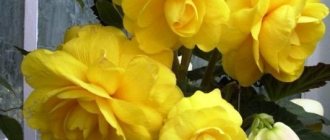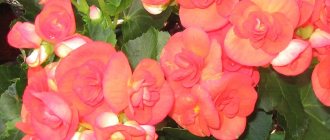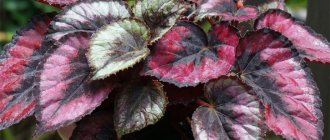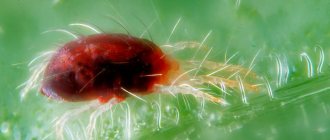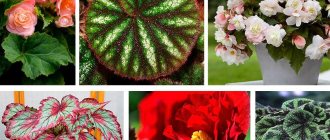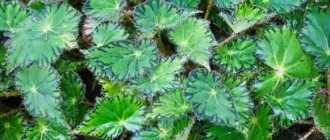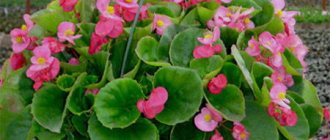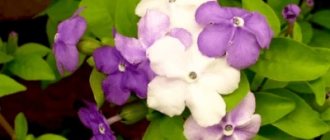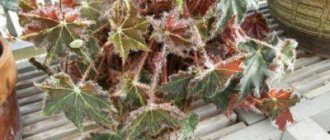Currently, many varieties of ever-flowering begonia have been bred, including those resistant to the temperature conditions of the cool summer of the middle zone.
Such varieties are cultivated as annuals , grown indoors and then planted outdoors in the spring, once the threat of frost has passed.
When the autumn cold snaps, the plants are removed.
Well-preserved strong specimens, which will serve as a source of cuttings for the growth of the next summer season, are sent for a warm winter.
- The following varieties of ever-flowering begonia are most suitable for such cultivation:
- Alba is tall, up to 40 cm, spreading, with dark green foliage and white flowers, collected in groups of 12 pieces.
- Kate Teicher - grows to a height of 40 cm, green leaves edged with red. The inflorescences are red, thirteen-flowered.
- Carmen is a medium-growing (25 cm) variety with very dark, lilac-brown foliage and pink flowers clustered in groups of six.
- Othello - 25 cm stems bear bright scarlet flowers that bloom in abundance.
- Albert Martin is a low-growing (15 cm) variety, green leaves with a red edge. Bright carmine-purple flowers are united in inflorescences of nine pieces. Up to 55 flowers unfold simultaneously on one plant.
- Bella is low (19 cm), decorated with green leaves bordered by red and dark pink nine-flowered inflorescences. 140 flowers can bloom at the same time.
- Bicola is a low-growing (13 cm) variety with green foliage and white flowers edged with pink, in clusters of four.
At the same time, even more numerous “ever-flowering” varieties are grown indoors .
Home care
Lighting
Bright light is needed. The best lighting will be provided by windows facing east or southwest . On windows in northern directions, as well as during the season of short daylight hours, for “eternal flowering”, additional lighting is needed - so that the light period is 16 hours a day. On the south and south-east side, shading may be required - especially in high summer.
Temperature
The best temperature range throughout the year is from 20 to 25 degrees. How to preserve ever-blooming begonia in winter?
In winter, you need to protect the root system from hypothermia (for example, on a cold windowsill), and in summer , prevent overheating of the stems and leaves .
If begonia semperflorens is kept in winter with short daylight hours, you need to switch it to rest mode - keep it at a temperature of 12 to 15 degrees, but not lower: a temperature of +12ºС is critical for an initially tropical plant.
Priming
The plant does not have any special requirements for the soil substrate: it must be slightly acidic, sufficiently loose, nutritious, with good air and moisture permeability .
You can use ready-made soil for begonias , or garden soil with a good dose of perlite or vermiculite, and also prepare a mixture of equal parts of leaf soil, humus and sand.
Landing
The planting container may be wide rather than deep (plant roots develop in the surface layer of soil), with a mandatory drainage hole . Since stagnation of water is extremely unfavorable, it is better to choose a porous container material - ceramics without a continuous layer of glaze .
A drainage layer must be placed at the bottom of the container , then soil is poured into a small mound, on top of which a predominantly horizontal root system is placed and the soil mixture is added to the required level, gradually compacting it.
In one container you can plant several plants quite close to each other - with a minimum feeding area of 10x10 cm for each.
Transfer
Replant as they grow : young specimens more often, mature specimens less frequently, up to the point of replacing the replanting with a partial renewal of the surface layer of soil in the pot. In this case, as a rule, old plants lose their decorative properties and are replaced by young ones grown from cuttings.
Watering
Water moderately, mainly in the morning or evening. The main goal in this case is to prevent the soil and root system from drying out, or stagnation of moisture in the soil.
Between watering with soft, not cold water, the soil should dry out a little.
If in winter this begonia is in a dormant period, at a temperature of 12-15 degrees and short daylight hours , the frequency of watering should be reduced .
Air humidity
It is necessary to maintain an atmosphere of high humidity , similar to the “native” tropics, but direct spraying of the bush does not benefit either the leaves or flowers: dark spots appear on them.
You should spray water around the begonia , or place wide vessels with water nearby, and place the pot on a tray with moistened pebbles.
Top dressing
Feed the plant once a month with a weak solution of mineral fertilizers with a slightly reduced nitrogen component. Potassium and phosphorus, necessary for flowering plants, must be present in full.
If the wintering of the ever-flowering begonia is warm and light , do not stop .
Growth and pruning
This species does not grow higher than 40cm, but pruning - mainly after wintering - is carried out : excessively elongated shoots are shortened, weak ones are removed.
When pruning in spring, you can also prepare cuttings for vegetative propagation.
Bloom
Potentially, “semperflorence” is really capable of always blooming, with all the tropical forces showing new and new, double and simple, inflorescences of diverse shades, combinations and transitions: from white and soft cream to ultra-dark red (read about double varieties here).
The main guarantee of such a wonderful phenomenon is constant light, moderate heat and moisture - both in the soil and in the air.
Wilted inflorescences, like dried leaves, should be removed in a timely manner.
Subspecies of flowers
ATTENTION : Begonia is an annual or perennial plant that has a huge number of varieties, differing in the size of the bush, the shape of the leaves, the colors of the inflorescences, and the type of growth. Among begonias, the most common are the flowering, decorative foliage, and tuberous groups.
- Blooming begonias are densely covered with inflorescences of various shades: white, pale yellow, orange, soft pink, scarlet, bright red. The texture of the flowers is double and semi-double.
- Decorative deciduous varieties are distinguished by a juicy green tint of leaves that have different shapes and sizes. This species does not have beautiful, decorative flowers.
- Tuberous begonias grow up to 50 cm in height, have a strong stem and large double flowers. Tuberous varieties are used for outdoor and indoor growing.
Reproduction
Begonia everflowering is propagated vegetatively - by cuttings and also by seeds .
It should be borne in mind that varieties with simple flowers completely retain all their characteristics when propagated by seed , while double forms lose them.
To preserve the splendor and color of double flowers , you need to use exclusively vegetative propagation .
Propagation by stem cuttings
Use spring and summer cuttings about 10 cm long, which have 2-3 pairs of leaves. The sections are dried and the lower leaves are removed.
You can pre-root the cuttings in water, treat the lower cuts with rooting stimulants, or immediately plant them in regular soil with additional sand.
The planting is covered with plastic film, kept warm (+ 22-25ºС ), ventilated and moistened.
After the formation of the root system and the formation of new shoots (within about a month ), the cuttings are planted in separate containers with a regular soil mixture.
Propagation by seeds
This method is often used for growing seedlings in open ground, in annual mode.
At the end of winter, small seeds are placed on the surface of the soil mixture, sprayed with water, covered with plastic film, ventilated, and kept at a temperature of 22-25ºC and good lighting .
Shoots appear in 2-3 weeks.
After the formation of two or three true leaves, the seedlings carefully dive, reduce the temperature to 17-18ºC and limit watering .
As they grow, they are seated. Flowering can begin as early as 12-20 weeks.
How to preserve young tubers
It is recommended to store young begonia tubers in winter in pots filled with moistened soil. Place several nodules in a pot and moisten the soil as it dries.
How to store begonia in winter:
- in the basement - at a temperature of 10 degrees and air humidity of at least 80%. “Adult” specimens will also overwinter here. They are placed in a box with a layer of sand and peat at the bottom. The tubers should not touch each other. The top of the “masonry” is covered with a storage mixture - vermiculite;
- in the refrigerator - dried tubers are placed in a bag with peat and vermiculite, holes are made for air; or packaged in a food container as for storage in the basement. Dryness of the filling mixture is the main condition for storing tubers;
- in an apartment - put the pot in a cool, dark and damp room, or place it near the balcony door, or store it on an insulated balcony; You should not move the pot from place to place and check the root system. How to preserve ampelous begonia in winter? Ampel varieties of begonias belong to the tuberous species and are stored as indicated above.
Signs of trouble
The leaves turn pale, the shoots stretch out - the result of insufficient lighting, especially in winter. It is necessary to ensure optimal light conditions and organize additional lighting during short daylight hours.
The intensity of flowering decreases due to excess bright light and excessive air humidity. The plant needs shading and ventilation.
The edges of the leaves turn brown and dry - dry air and overheating. Exposure to direct sunlight should be limited and the air humidified.
The buds are falling, the flower buds are drying - low air humidity. It needs to be moisturized additionally.
Begonia drops flowers - this happens with a sharp change in temperature and humidity; can be observed in a recently acquired or suddenly moved specimen - as a stress reaction that passes as it adapts to new conditions, if they meet the needs of the plant.
Leaves and stems turn black - usually in frostbitten specimens grown in open ground. Select undamaged, strong bushes, transplant them into pots and transfer them to a warm room.
Preparing for winter
Flowers should be prepared for winter sleep long before it begins.
Preparation includes the following steps:
- If the bush produces new buds in October, they should be removed. This way the plant will not waste its energy on new flowers - they will go into the root crop.
- Feeding stops about a month before digging.
- The first light frosts will not damage the plant, but they will be a signal that it is time to bring the begonia into the house. By this time, the leaves should turn yellow and the stem should wither. Some gardeners, without waiting for frost, bring in bushes from the street when the temperature drops to +10 °C.
- Potted begonia is simply brought into a room where it is dry and cool, stopping watering. A bush growing in a flowerbed should be dug up along with a ball of soil and brought into the house. In about 14 days, the nodules will pull out everything useful from the stems and gain strength for rest.
- The stems are cut off, leaving stumps 1–2 cm high. The potatoes are cleared of the soil and left for 1–2 weeks to dry.
- To put in a box, you need to select only healthy and beautiful tubers (not overdried, dense, without mold or rot).
Indoor begonias in pots are prepared for winter by gradually reducing watering until it stops completely. Then the wilted stems are cut off at ground level. There is no need to dig up the root crop.
Did you know? The tubers of this beautiful flower can be eaten. They have a citrus flavor.
Diseases and pests of everflowering begonia
Care errors, primarily stagnation or lack of moisture in the soil , weaken the plant and provoke its defeat by powdery mildew . In this case, you need to optimize watering and treat the begonia with fungicides.
The combination of high humidity and low temperature leads to the development of root or leaf rot .
If the process has just begun, you should urgently optimize the temperature and humidity conditions and remove damaged parts.
In case of severe damage, you will have to root cuttings cut from healthy shoots and keep them in appropriate conditions, and get rid of the rest of the plant.
Begonia can be attacked by whitefly, thrips and scale insects . As a first measure, remove pests using a cotton swab dipped in alcohol or treatment with a soap solution. The most effective pest control is systemic insecticides.
In a room with humidified air, where it is warm and light all year round, the ever-blooming begonia (Begonia semperflorens) fully lives up to its promising botanical name, almost continuously forming and unfurling flower buds throughout all four seasons.
Why can't begonias be left outside in winter?
According to scientists, there are more than 1 thousand species of begonias in nature. Almost all of them live in tropical and subequatorial forests of Africa and South America, as well as on the islands and coasts of the Indian Ocean. As representatives of a warm and fairly humid climate, in our latitudes these flowers prefer indoor conditions and do not tolerate even the slightest frost.
56967.jpg
However, there are species adapted to relative cold - tuberous begonias. They were originally discovered in the Andes (Peru, Bolivia) in the 60s of the 19th century, and subsequently became the basis for the selection of many cultivated varieties. To survive in the mountains with cool winters, plants learned to accumulate moisture and microelements in thickened roots - tubers, which made their flowers even larger than those of their tropical relatives that bloom all year round. But it should be noted that the temperature in the Southern Andes never drops below +3°C, and in the harshest months it stays at +7...10°C. In summer, the mountain belt also does not warm up much - only up to +15...20°C, and besides, it often drizzles and fogs there.
begonia_walsall_485151_1920x1200.jpg
Photo
Below you can see photos of planting and caring for Begonia Everblooming at home:
Decorative foliage plants
But due to the fact that daylight hours decrease in winter, natural light becomes insufficient for these plants.
Therefore, with intensive watering, they develop incorrectly, stretch out and become thinner.
In order for decorative deciduous begonia to grow more slowly in winter, its temperature is reduced and watering is reduced. In winter, such varieties are kept at a temperature of about 16ºC and watered only when the top layer of soil in the pot dries out.
In winter, it is undesirable to keep decorative deciduous begonia at room temperature, since at high temperatures (22-26ºC) frequent watering of the plant is necessary.
To prevent the plant from stretching out when watering frequently, you need to provide it with good lighting. But since even on southern windows in winter there is not enough light for begonias, you will have to organize additional electric lighting for at least 6 hours a day.
Peculiarities
If begonia is kept at low temperatures in winter, it must be watered very sparingly. The top layer of soil must dry out to a depth of at least 3 cm between waterings, otherwise the roots of the plant will rot very quickly.
Popular articles Application and properties of pine essential oil
Excessive humidity at low temperatures leads to fungal diseases of these flowers.
The surface of the soil should dry out between waterings. You need to place the flower on the most illuminated windowsill. Direct sun in winter will not harm the plant.
Begonia should not be placed near heating radiators. The air near heating appliances becomes very dry in winter, and this is harmful to the plant. With low humidity, the leaves may begin to dry out.
To prevent this from happening, you should move the begonia to a windowsill away from radiators and take care to humidify the air in the room. You cannot spray the flower so that water gets on the leaves; it is enough to spray the moisture near the plant.
The disturbed root system of the plant recovers very slowly in winter and is susceptible to disease. Cuttings for rooting are not cut in winter, since at this time they slowly take root and often rot.
